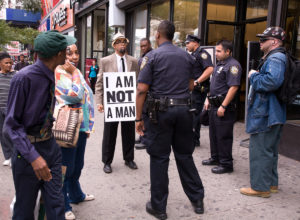
I Am Not a Man; performance; 2009; duration 1 hour. Performance still 22 x 30 inches, pigment print.
“I Am Not a Man. I am but I am not. I Am Not a Man was a performance that was presented on the streets of Harlem, New York. I walked bearing a historic, but crucially altered, protest sign that read “I Am Not a Man.” Throughout the walk, actions in the performance evoked the humiliation that is visited on Black people and the negation that defines our existence.
Making reference to the 1968 Memphis Sanitation workers strike where the iconic “I Am a Man” sign originated, the performance inverted the sign’s statement, pointing to the importance of the Civil Rights protests as well as to their limitations. Along with this historic resonance, the performance simultaneously addressed our era—racism is foundational to America and has not abated. Despite assertions that America has entered a post-racial period, reality contradicts this: 1 in 9 young Black men are in prison; predatory lending policies have caused the greatest loss of wealth for people of color in modern U.S. history; Henry Louis Gates gets arrested “breaking into” his own home; etc.
I Am Not a Man resides in the uncomfortable space between a race-free fantasy world and the lived experience of millions.
The performance took place September 9, 2009.
I Am Not a Man is part of Rate of Change, a suite of street performances that I will be performing throughout New York in the coming months. Other works in the project include Kidney for Sale and Money to Burn. Announcements of the locations dates and times of these works will be available on the upcoming page.
This performance was made possible, in part, by the Franklin Furnace Fund supported by Stimulus funds from the New York State Council on the Arts, a state agency; the Lambent Foundation; and Jerome Foundation.
Dread Scott makes revolutionary art to propel history forward. He first received national attention in 1989 when his art became the center of controversy over its use of the American flag. President G. H.W. Bush declared his artwork What is the Proper Way to Display a U.S. Flag? “disgraceful” and the entire US Senate denounced this work and outlawed it when they passed legislation to “protect the flag.” To oppose this law and other efforts which would effectively make patriotism compulsory, he, along with three other protesters, burned flags on the steps of the US Capitol. This resulted in a Supreme Court case and a landmark First Amendment decision.
His art has been exhibited at the MoMA PS1, the Contemporary Art Museum Houston, The Walker Art Center and at the Pori Art Museum in Pori, Finlandas well as on view in America is Hard to See, the Whitney Museum’s inaugural exhibition in their new building. In 2012, BAM (Brooklyn Academy of Music) presented his performance Dread Scott: Decision as part of their 30th Anniversary Next Wave Festival. In 2008, the Museum of Contemporary African Diasporan Arts presented Dread Scott: Welcome to America. Winkleman Gallery and Cristin Tierney in New York have exhibited recent work and his public sculptures have been installed at Logan Square in Philadelphia and Franconia Sculpture Park in Minnesota. His work is in the collection of the Whitney Museum of American Art, the New Museum of Contemporary Art (NY) and the Akron Art Museum (OH).
He is a recipient of a Creative Capital Foundation grant, a Pollock Krasner Foundation grant, Fellowships from the New York Foundation for the Arts, and was a resident at Art Omi International Artists Residency and the Workspace Residency at the Lower Manhattan Cultural Council.
He has been written about in The New York Times, Art In America, Sculpture Magazine, ArtNews, ArtForum, Art21 Magazine, Time, The London Guardian and several other newspapers, magazines and books. He has appeared on numerous local and national TV and radio shows including Oprah, The Today Show, and CBS This Morning speaking about his work and the controversy surrounding it.
His work has been integrated into academic curricula and What is the Proper Way… is discussed in many art history classes and is featured in Henry Sayer’s “foundations” text A World of Art.
Dread works in a range of media including performance, photography, screen printing, video, installation and painting. His works can be hard-edged and poignant. He plays with fire—metaphorically and sometimes literally—as when he burned $171 on Wall Street and encouraged those with money to burn to add theirs to the pyre. The breadth of media he explores is unified by the themes he addresses and how he handles them. His art illuminates the misery that this society creates for so many and it often encourages the viewer to envision how the world could be.


